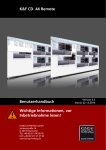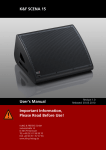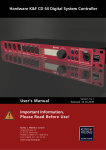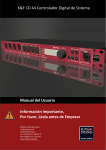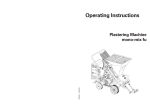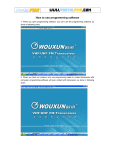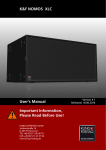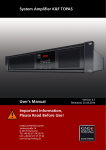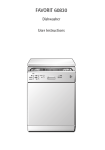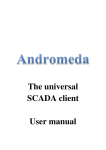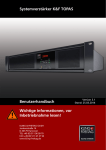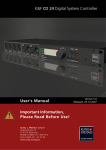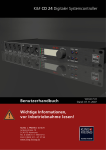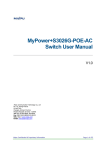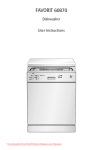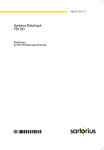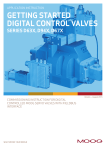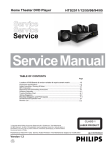Download CD Remote for K&F CD 24 / CD 44 Important - AV
Transcript
CD�Remote�for�K&F�CD�24�/�CD�44 User's�Manual Important�Information, Please�Read�Before�Use! KLING & FREITAG GmbH Junkersstraße 14 D-30179 Hannover TEL +49 (0) 511 96 99 70 FAX +49 (0) 511 67 37 94 www.kling-freitag.de Revison 4.0 Released: 15.03.2011 User's manual CD Remote for K&F CD 24 / CD 44 Table of contents 1 Introduction 6 1.1 Symbols in User's Manual 6 1.2 Information about this User's Manual 6 2 General�Information 7 2.1 Extent of this Manual 7 2.2 Terminology 7 2.3 Overview of the software windows 9 3 Scope�of�Delivery 10 4 Product�Description 10 5 Requirements 10 5.1 Personal Knowledge 10 5.2 System Requirements 10 5.3 Requirements for the CD 24 11 5.4 Requirements for the CD 44 11 Connection�to�the�Computer 12 6.1 Connection of the CD 24 12 6.2 Connection of the CD 44 12 6 7 Installation 12 7.1 Installation of the Software 12 7.2 Setting Up the IP Addresses 13 7.2.1 Setting IP Addresses for the PC 13 7.2.2 Setting the IP Address on the CD 44 14 8 Passwords�and�Access�Rights 14 9 Starting�the�Software�and�Logging�On�the�Controller 16 9.1 Starting the Software 16 9.2 Logging On the Controller 16 9.2.1 Selecting the IP Address of the PC in the Software 16 9.2.2 Selecting the COM Port 17 9.3 10 10.1 10.1.1 10.2 11 Calling the Controller in the Software 17 Menus�in�the�Main�and�Login�Windows 18 Short Description of Main Window Menus Global settings 20 Menus of the Login Window (DeviceList) Changing�/�Saving�Device�Settings 11.1 11.1.1 General Procedure for the System Setup Brief Description of the Menus in the Device Window KLING & FREITAG GMBH © 2010 18 Revision 4.0 21 22 22 23 Page 3 of 55 User's manual CD Remote for K&F CD 24 / CD 44 11.2 Load and Save Current Setups (Current Setup) 23 11.3 Changing General Settings (Device) 25 11.3.1 Changing the Controller Name (Name) 25 11.3.2 Changing Passwords (Passwords) 25 11.3.3 Changing the User Group (Device Mode) 26 11.3.4 Device Info 26 11.4 Organizing the Controller’s Memory (Memory Organization) 27 11.4.1 Organizing Setups 27 11.4.2 Organizing Equalizer Presets (EQ-Sets) 28 11.4.3 Organizing Speakers (LSBlocks) 29 11.4.4 Complete Backup 30 12 Input�Patching�(Input�Configuration) 32 12.1 Available input patchings 32 12.2 Selecting Patchings 32 13 Routings 33 13.1 Available routings 33 13.2 Selecting Routings 33 14 Setting�Filters,�Limiters�and�Delays 34 14.1 Overview of the Symbols 34 14.2 Changing Parameters 34 14.2.1 Parametric Filters 35 14.2.2 Anti Air-loss Filter 36 15 Link�manager,�links�of�function�blocks 39 15.1 Linking Function Blocks 40 15.2 Organizing and Deleting Links 41 16 Scenarios 43 16.1 Loading Scenarios 43 16.2 Saving scenario 43 17 Working�with�Virtual�Controllers�(Offline�Devices) 44 17.1 Creating Virtual Controllers 44 17.2 Deleting Virtual Controllers 45 17.3 Transmitting Settings between Virtual and Real Controllers 45 17.3.1 Transfer Scenarios from Virtual Controllers to Real Controllers 46 18 Updating�the�CD�Remote�Software 48 19 Replacing�the�IP�Card�and�Updating�the�Firmware 50 19.1 Safety Instructions 50 19.2 Replacing the IP Card 50 19.3 Updating the Firmware 51 KLING & FREITAG GMBH © 2010 Revision 4.0 Page 4 of 55 User's manual 20 CD Remote for K&F CD 24 / CD 44 19.3.1 Downloading Firmware 51 19.3.2 Starting the Flashloader 52 Index KLING & FREITAG GMBH © 2010 54 Revision 4.0 Page 5 of 55 User's manual 1. CD Remote for K&F CD 24 / CD 44 Introduction Thank you for your decision to buy a KLING & FREITAG product. Before starting the software please read the manual properly to ensure a failure-free operation. As a user of the software you now have a versatile and highly professional tool which, when operated properly, is a true pleasure to use 1.1 Symbols�in�User's�Manual This symbol indicates the possibility of life-threatening danger and a health risk for persons. Not following these instructions may result in serious health problems including potentially fatal injuries. Warning This symbol indicates a possibly dangerous situation. Not following these instructions may cause minor injuries or cause property damage. Caution This symbol gives instructions for the proper use of the described products. Not following these instructions may cause malfunctions or property damage. This symbol indicates notes that help you to handle the described products easier. Tip 1.2 Information�about�this�User's�Manual All specifications in this manual are based on information available at the time of publishing for the features and safety guidelines of the described products. The manufacturer reserves the right to make product alterations within legal provisions as well as changes to improve product quality. All�persons�who�use�the�speaker�system�must�have�this�guide�and�all�further�information�for safe�operations�available�to�them�during�assembly,�disassembly,�and�use.�The�speaker�system may�neither�be�set�up�nor�used�until�this�manual�has�been�read,�understood�and�kept�readily available�on�site. We appreciate any input with suggestions and improvements for this manual. Please send this to us at the following address: [email protected] or to: KLING & FREITAG GMBH Junkersstr.14 D-30179 Hannover. Phone +49 (0) 511 - 96 99 70, Fax +49 (0) 511 - 67 37 94 KLING & FREITAG GMBH © 2010 Revision 4.0 Page 6 of 55 User's manual 2. 2.1 CD Remote for K&F CD 24 / CD 44 General�Information Extent�of�this�Manual This manual is for the software enabling the remote control of the CD 24 and CD 44 System Controllers using PC software (remote software). If the controllers are equipped with different functions, this will be specially indicated. This manual supplements the manual that was provided with the Controller itself (hardware manual), therefore you will not find any detailed descriptions of the individual features (i.e. of the filters). When such features are mentioned, you will find references to the relevant pages in the hardware manual. Additional functions that are only available using the software are described in detail in this manual. Please�observe�the�chapter�“General�Safety�Instructions”�in�the�hardware�manual�for�the K&F�Controller�CD�24�/�CD�44.�This�is�especially�important�for�the�connections�and�the�installation�location�of�the�controller. Caution 2.2 Terminology Complete Function to save a backup copy of all controller data (Complete Backup). File extension *.dcc EQ-Set Settings for the graphic equalizer that can be separately saved and loaded. File extension *.dec Firmware The software that is installed in the controller is called “Firmware” in this manual. Function�Blocks The Controller CD 24 / CD 44 is equipped with various functions that are called Function Blocks: • Graphic Equalizers (CD 44 only) • Input Gains • Input Delay (CD 44 only) • Limit Reduction • Output Gain • Output Delay Input�Patching With the input patching, you can configure the physical inputs. This way, you can, for example, correct physically flipped inputs in the controller without having to change the actual connectors, you can select if you want to connect a digital or analogue signal to the inputs or you can create a mono-sum of the inputs 1 and 2. Link/Link�Manager Links connect corresponding Function Blocks and are controlled by the Link Manager, which can also create links between several controllers. The entry Link in the device window only provides an overview of the links. See Chapter [Link Manager] on page 39. Memory Refers to the memory that is installed in the controller. See Chapter [Organizing the Controller’s Memory (Memory Organization)] on page 27. Offline In the login window, you have the possibility to create virtual controllers – so-called Offline Devices. On these controllers, you can edit the settings to transfer them to a real controller later. See Chapter [Working with Virtual Controllers (Offline Devices)] on page 44. KLING & FREITAG GMBH © 2010 Revision 4.0 Page 7 of 55 User's manual CD Remote for K&F CD 24 / CD 44 Online If the CD Remote Software recognises real controllers connected to the PC, the software refers to them as Online Devices. Scenario Scenarios include the setups and settings of all opened controllers’ graphic EQ’s, all set links, and the position and size of the software interface’s individual windows. You can save and load scenarios. See Chapter [Scenarios] on page 43. Setup Setups are the settings of the individual routings, filters, limiters, delays, etc. that are saved in the controller or on the PC. A [Current Setup] is the active setup in the controller. There are various example setups saved in the controller, the so-called "Examples". The settings of the graphic equalizers do not belong to the setup; these can be saved separately. See Chapter [Load and Save Current Setups (Current Setup)] on page 23. Routing The routings determine how one or several input signals can be switched to the outputs and which path these signals will take. You can find detailed descriptions of examples with the corresponding circuitry and connection diagrams in the hardware manual. Software In this manual, the software that you install onto your PC is referred to as “Software” or “Remote Software”. Speakers Speakers correspond to the LSBlocks in the controllers. These are speaker-specific sets of parameters that have been specially created for available K&F speakers. You must assign the Speakers to the controller outputs; the Speakers must correspond to the real speakers that are to be connected there. KLING & FREITAG GMBH © 2010 Revision 4.0 Page 8 of 55 User's manual 2.3 CD Remote for K&F CD 24 / CD 44 Overview�of�the�software�windows The most important windows in the software interface are the “Main Window” where the software runs, the “Login Window,” and the “Device Window”. If several controllers are logged on, then the corresponding number of device windows may be open. Via the device window, the respective subwindow can be opened for the relevant controller’s settings. In the software, the main window is labelled with CD�Remote, and the login window with DeviceList. Each device window shows the name of the controller in the top frame. Main Window: Login Window: Device Window: KLING & FREITAG GMBH © 2010 Revision 4.0 Page 9 of 55 User's manual 3. CD Remote for K&F CD 24 / CD 44 Scope�of�Delivery The latest version of the remote software for operating the controller can be downloaded from the Kling & Freitag website (www.kling-freitag.de). In addition to the remote software, this package also contains the user's manual as a PDF file and software for updating the firmware (Flashloader), including up-to-date firmware as well as the data for the current K&F speakers (Speakers / LSBlocks). 4. Product�Description With the software, you can carry through and administrate all settings on the Controller CD 24 / CD 44, i.e.: Organizing�setups�on�the�hard�drive�and�loading�to/from�controller You can load and edit the current settings from the controller’s memory (from Memory) and save them onto your PC (to File) or in the controller (to Memory). Creating�and�saving�scenarios You can save all settings of all opened Controllers – including the setups, links and the graphic EQ-settings – onto the PC as Scenarios. Linking�several�controllers�(Master�–�Slave) You can link multiple controllers with the software, enabling you to adjust the settings for several controllers simultaneously. Backup You can create a backup copy of all settings with the [Complete] function. Settings • Password administration • Operating modes You can find a description of the individual settings in the respective sections of the hardware manual. 5. Requirements 5.1 Personal�Knowledge To operate the controller using the remote software, you should have basic working knowledge of Microsoft Windows and be familiar with operating the Controller CD 24 / CD 44. For this, see the corresponding user's manuals. 5.2 System�Requirements Hardware: CD 24: A PC with an RS232 or USB port incl. a USB-RS232 converter; firmware version 3.55 or higher. CD 44: a PC with Ethernet 10/100Base-TX network connection; firmware version 3.46 or higher. Software: The software was tested with Microsoft Windows XP. Operating systems other than Microsoft Windows are not supported! You can download the relevant current remote software from the download area of the Kling & Freitag website (www.kling-freitag.de). KLING & FREITAG GMBH © 2010 Revision 4.0 Page 10 of 55 User's manual 5.3 CD Remote for K&F CD 24 / CD 44 Requirements�for�the�CD�24 Connect the controller to the mains voltage and determine the revision number in the controller. To do so, open the following menus in the controller: 1. Click [Util] -> [Info], [FWRev] or [SWRev]. If the firmware has a revision number lower than 3.55, then you must update the firmware. To do this, follow the steps as described in Chapter “[Updating the Firmware]” on page 51. On older controllers, SWRev appears on the display instead of FWRev. 5.4 Requirements�for�the�CD�44 Connect the controller to the mains voltage and determine the revision number in the controller. To do so, open the following menus in the controller: 1. Click [Util] -> [Info], [FWRev] or [SWRev]. If the firmware has a revision number lower than 4.0, then you must load a firmware update into the controller. With a firmware revision number less than 3.4, you must also replace the IP Card built into the controller. To do this, follow the steps as described in Chapter "[Replacing the IP Card and Updating the Firmware]" on page 50. On older controllers, SWRev appears on the display instead of FWRev. You can request an updated IP card in exchange for the old card from K&F. KLING & FREITAG GMBH © 2010 Revision 4.0 Page 11 of 55 User's manual 6. Connection�to�the�Computer 6.1 Connection�of�the�CD�24 CD Remote for K&F CD 24 / CD 44 To connect the CD 24 to your computer, you have to use a RS232 cable. Alternately, you can use the USB port of your computer. In this case, you need a USB - RS232 (male) adapter. 6.2 Connection�of�the�CD�44 To connect the CD 44 to your computer, you have to use an Ethernet network cable and a switching hub. Alternately, you can connect the CD 44 directly (without a switching hub) to your computer. In this case, you need a cross-linked Ethernet cable or a crossover adapter. Some network interface cards automatically recognise the transmission and reception wires of the connected controller and adapt to them. This function is referred to as Auto-MDI(X). In this case, the type of cable used (cross-linked or normal) is irrelevant. To find out if your network interface card is equipped with Auto-MDI(X), consult your network interface card’s documentation. 7. 7.1 Installation Installation�of�the�Software Copy the file [CD Remote Installer Vx-xx.zip] onto your PC. You can download the file from the download area of the Kling & Freitag website (www.kling-freitag.de). Unzip the file and start the installation with a double click on the file [CD Remote Installer VX-XX.exe] and follow the installation instructions on the PC monitor. KLING & FREITAG GMBH © 2010 Revision 4.0 Page 12 of 55 User's manual 7.2 CD Remote for K&F CD 24 / CD 44 Setting�Up�the�IP�Addresses CD�44�only! 7.2.1 Setting�IP�Addresses�for�the�PC 1. On the Windows desktop, go to [Start] -> [Settings] -> [Control Panel] -> [Network Connections] -> [LAN Connection] (double click) -> [Properties] -> [Internet Protocol (TCP/IP)] -> [Properties] -> [Use the following IP address] 2. Set a fixed IP address (i.e. 192.168.0.100). The first three digit fields of the computer’s and controller’s IP addresses must be identical. The last digit field must be different, ranging between 1 and 254. If you connect several controllers, then each one must have a different final digit field or the communication will fail. Please do not change the subnet mask address 255.255.255.0 without a special reason. The controller’s IP address that is set at delivery is 192.168.0.XX. The last two digits are identical with the last two ones of the serial number. 192.168.xxx.xxx is reserved for private networks and is therefore recommended. 3. Click [OK] twice to save the changes. If your system requires dynamic IP addresses, go to Alternative Configuration and enter the desired address for the controller at User-Defined. This way you can use a static IP address in a network environment with dynamic addresses. In any case, the controller itself requires a static IP address. KLING & FREITAG GMBH © 2010 Revision 4.0 Page 13 of 55 User's manual 7.2.2 CD Remote for K&F CD 24 / CD 44 Setting�the�IP�Address�on�the�CD�44 As an alternative to the steps described above, you can change the IP address of the controller to match that of your computer. In this case, the first three fields of the IP address have to match. 1. Click [Util] -> [IP-Address]. The new IP address is valid after the controller has been restarted! Tip 8. Passwords�and�Access�Rights The controller differentiates between three different access modes that are called Master, User and Lock all as well as one password for each of them. You can find information about changing the passwords and the different modes in “[Changing General Settings (Device)]” on page 25. Administrator�Password:�The administrator password depends on the serial number and cannot be changed. It is provided with a sticker on delivery and is required to change the master and user passwords. If you forget the master password, you can use the administrator password instead. Master�and�User�Passwords:�The default password for the master mode is master, and for user mode user. Please note the lower case spelling. We recommend that the owner of the controller changes the user and master passwords before others use it. This ensures that no settings are made by unauthorised persons, which could result in the malfunction or damage of speakers. Passwords will be reset to the default passwords after updating the software. The 3 different access modes: Master: In the master mode, the full range of operations is possible. To access this mode, you need either the master or the administrator password. User: Users only have access to a limited range of operations (they cannot change setups or LS blocks, etc.). This mode is appropriate when you lend out the controller, for example, and you do not want the user to make any fundamental changes or adjustments that could possibly endanger the operating safety. The corresponding functions are grey and thus not selectable in the software. To access this mode, you need the user password. Lock�all:�No adjustments of any kind can be made on the controller. This mode protects the controller from unauthorized access. If a controller is started with an incorrect password or no password whatsoever, then it starts in the Lock all mode. There is also a differentiation between the device mode and the software mode. The Device�mode�defines the operating rights in the controller when it is not being operated with the remote software. KLING & FREITAG GMBH © 2010 Revision 4.0 Page 14 of 55 User's manual CD Remote for K&F CD 24 / CD 44 The Software�Mode�defines the operating rights in the remote software, irrespective of the device mode. The appropriate mode is selected by entering the password when logging in. The device window is started in the software mode that corresponds to the password entered at login. If no password or an incorrect password is entered, it is started in the Lock all mode. See Chapter [Calling the Controller in the Software] on page 17. If the controller is logged off, it returns to its original device mode. The passwords for the device mode and the software mode are identical. If a controller is logged into the remote software, then operations on the controller itself are blocked. KLING & FREITAG GMBH © 2010 Revision 4.0 Page 15 of 55 User's manual 9. Starting�the�Software�and�Logging�On�the�Controller 9.1 1. CD Remote for K&F CD 24 / CD 44 Starting�the�Software Click [Start] -> [All Programs] -> [KlingFreitag CD Remote] -> [CD Remote]. 9.2 Logging�On�the�Controller 9.2.1 Selecting�the�IP�Address�of�the�PC�in�the�Software CD�44�only! You must select the IP address directly in the remote software. In case there are several network participants with separate IP addresses (i.e. several network adapters), you must select the adapter that you would like to use. 1. Click [Edit] -> [Connection Settings]. 2. In the area [IP Settings]Activate the control box [Enabled]. 3. Your PC’s IP address is shown. If several IP addresses are assigned or several network interface cards are installed, select the appropriate IP address. 4. If your network does not recognise the controller, it is possible that it did not have enough time to scan all network addresses. In this case, increase the time for the Network Polling (a value that is too high slows its locating your controller). The maximum value is 200 ms. KLING & FREITAG GMBH © 2010 Revision 4.0 Page 16 of 55 User's manual 9.2.2 CD Remote for K&F CD 24 / CD 44 Selecting�the�COM�Port CD�24�only! 1. Start the remote software using the Windows Start menu. 2. Click on [Edit] -> [Connection Settings]. 3. In the area [Serial Settings]Activate the control box [Enabled]. 4. Select the COM Port that the controller is connected to. 9.3 Calling�the�Controller�in�the�Software When the software has been started, it automatically looks for controllers in the network. Connected CD 44 are only recognised, though, when the first three digit fields of all controllers’ IP addresses are identical and each last field has a different value. Connected CD 24 are only recognised when the correct COM Port Number is set. After a few seconds, all of the connected controllers should be shown. 1. Click Password [ ] . Enter the password of the access mode that you want to login to. If the software has been started with an incorrect password or no password whatsoever, then it starts in the Lock all mode. The PC saves each last-used password and uses it for the next login attempt. KLING & FREITAG GMBH © 2010 Revision 4.0 Page 17 of 55 User's manual CD Remote for K&F CD 24 / CD 44 To delete the password from the entry mask, take the following steps: 2. In the main window, click [Edit] -> [Clear Stored Passwords] Upon delivery, the name of the controller is “Unit 1”. If you want to work with several controllers online, you must give the controllers different names. See Chapter [Changing the Controller Name (Name)] on page 25. 3. Activate the control box [Online]. The device window is opened and the controller is online. The controller’s IP address and “Remote Controlled” are shown on its display, thus making manual operation on the controller itself no longer possible. Devices with extended memory are highlighted in the DeviceList Window. Tip 10. Menus�in�the�Main�and�Login�Windows 10.1 Short�Description�of�Main�Window�Menus Name Submenu Function Edit Connection Settings Connection Settings Clear Stored Passwords Clears all passwords stored in the PC Load from File Load scenarion from PC Save to File Save scenario on PC Link Manager Link function blocks of one or several controllers. See Chapter [Link manager, links of function blocks] on page 39. Global Settings Global settings for Anti-Air-Loss filter and for activation and storage directory of the Complete Defaults for offline devices. Scenario Options Info KLING & FREITAG GMBH © 2010 Software version information Revision 4.0 Page 18 of 55 User's manual CD Remote for K&F CD 24 / CD 44 Name Function DeviceList Brings the login window to the front Unit 1, Unit 2, [device name] Device window of the corresponding controller is brought to the front KLING & FREITAG GMBH © 2010 Revision 4.0 Page 19 of 55 User's manual 10.1.1 CD Remote for K&F CD 24 / CD 44 Global�settings Change global settigns at: Click [Options] -> [Global Settings]. Setting Function Delay/Units Choose the delays in meters or milliseconds Velocity Acoustic velocity air attributes H: Relative humidity T: Air temperature Offline Devices Activate the checkbox if Offline Devices (virtual devices) should have complete preset data and settings. In the menu, enter which setting file should be loaded after creating a virtual controller. The checkbox is activated by default and the [CDX4 Complete Defaults VX-XX.dcc] provided upon delivery is loaded. To create your own Complete Defaults, follow these steps: In the device window, click [Memory Organization] -> [Complete] -> [SaveToFile]. Refer to chapter [Working with Virtual Controllers (Offline Devices)] on page 44. KLING & FREITAG GMBH © 2010 Revision 4.0 Page 20 of 55 User's manual 10.2 CD Remote for K&F CD 24 / CD 44 Menus�of�the�Login�Window�(DeviceList) Name Function Name Name of the CD 24 / CD 44 Controller CD 24 / CD 44 Interface IP address of the CD 44 / COM Port of the CD 24 Password Password (“assigned” indicates that a password for the controller has been saved on the PC) Status Found: Controller recognised Loaded: Controller signed on and setup loaded Closed: Controller signed off. 2 This checkbox is only available for controllers that are connected with the computer. If this checkbox is activated, the device window opens and the controller can be operated using the software. It is no longer visible for other users in the network. 2 This checkbox is only available for virtual controllers. If this checkbox is activated, the device window opens and the virtual controller can be operated using the software. Online ) Offline ) Refer to chapter [Working with Virtual Controllers (Offline Devices)] on page 44. FWRev Firmware version HWRev Hardware version (circuit boards) SN Controller’s serial number 2)�Devices with extended memory are highlighted in the DeviceList Window. KLING & FREITAG GMBH © 2010 Revision 4.0 Page 21 of 55 User's manual CD Remote for K&F CD 24 / CD 44 11. Changing�/�Saving�Device�Settings Changed settings are saved onto the controller in intervals of approx. 5 seconds so that any changes to the settings are saved in the case of a loss of power, for example. If you switch off the controller, these settings remain active. The changes made to the setups, however, are not saved automatically. You must manually save them after finishing the settings. Refer to chapter [Load and Save Current Setups (Current Setup)] on page 23. 11.1 General�Procedure�for�the�System�Setup If you want to set up a system configuration, start by mapping the wired hardware in the software and adjust the setup details afterwards. Proceed as follows: 1. Select the desired routing. 2. Select the desired input patching. 3. Select the connected speakers. 4. Adjust the individual filters, limiters, etc. 5. Create the desired master operating elements 6. For setups with several controllers, you can save the complete configuration as a scenario. You can find a detailed description of the system configuration in the hardware manual. Menus in the Device Window KLING & FREITAG GMBH © 2010 Revision 4.0 Page 22 of 55 User's manual 11.1.1 CD Remote for K&F CD 24 / CD 44 Brief�Description�of�the�Menus�in�the�Device�Window Name Submenu Function Current Setup Load/Save active Setups from/to PC/controller Load from Memory Load setup from controller Load from File Load setup from PC Save to Memory Save setup on controller Save to File Save setup on PC Memory Organization Load / save without the setups in the controller being changed. (In complete backup, even the current setups will be overwritten) Setups Organizing Setups EQ-Sets Organize equalizer presets Speakers Organize speaker sets (LSBlocks) Names Function not available for user PrefilterRest Function not available for user Complete Load / save a backup copy of all controller data (Complete Backup) Device Organize general settings Name Change device names Passwords Change passwords DeviceMode Change access rights / access mode You can find detailed descriptions of the submenus in the following chapters. 11.2 Load�and�Save�Current�Setups�(Current�Setup) In the menu Current Setup, you can load the setups from the controller’s memory or from the PC into the random access memory of the controller. By default, the CD 24 is delivered with five (Example 1 - 5), the CD 44 with fourteen (Example 1 - 14) exemplary setups. You can change the corresponding setups and save them under another name as new setups. A total of up to 64 setups can be saved in the controller. The file name extension .dsc is automatically assigned when you save a setup on the PC. If you make changes in the current setup, an asterisk (*) appears under Setup Loaded:[Setupname]. This�applies�for�setups�with�the�same�name�too!�If�a�setup�is�loaded�from�a�file�with�[Current Setup]�->�[LoadFromFile]�or�from�a�scenario,�the�current�setup�will�be�overwritten. KLING & FREITAG GMBH © 2010 Revision 4.0 Page 23 of 55 User's manual CD Remote for K&F CD 24 / CD 44 Load�From�Memory Loading setups from the controller´s memory: In the device window, click [Load From Memory] -> [Selecting a file] -> [OK]. Load�From�File Loading setups from the PC: With [Load From File] -> [Open], you can open the setups that are saved in the computer. In the device window, click [Load From File] -> [Selecting a file] -> [Open]. The files are saved in .dsc format (Example 1.dsc, etc.). If you want to keep your Setup in the controller, even after switching off the CD44, you have to store your Setup with [Save To Memory]. Save�To�Memory Saving the current setup in the controller: In the device window, click [Save To Memory] -> [Select a name] or [new] -> [OK]. Save�to�File Saving the current setup on the PC: In the device window, click [Save to File] -> [Select a path] and [Select a name] -> [Save]. The name of the setup is kept, independant of chosen file name. If you want to rename the setup in the device window (Setup Loaded:), then you must do so by first saving it in the device. In the device window, click [Save To Memory] -> [Select a name] or [new] -> [OK]. Tip KLING & FREITAG GMBH © 2010 Revision 4.0 Page 24 of 55 User's manual 11.3 CD Remote for K&F CD 24 / CD 44 Changing�General�Settings�(Device) In this menu, you can change device names, passwords, and access rights. 11.3.1 Changing�the�Controller�Name�(Name) If you use several controllers in a network, it is essential that the controllers have different names. Otherwise, the controllers cannot be addressed in the network. You can choose any name you wish. You can change the name as follows: 1. Open the device window. 2. Click [Device] -> [Name]. 3. Enter the new name. 4. Click [OK]. 11.3.2 Changing�Passwords�(Passwords) You can change the passwords as follows: 1. Open the device window. 2. In the device window, click [Device] -> [Passwords]. 3. Enter the administrator password. 4. Select the password that you want to change. 5. Enter the new password. KLING & FREITAG GMBH © 2010 Revision 4.0 Page 25 of 55 User's manual 11.3.3 CD Remote for K&F CD 24 / CD 44 Changing�the�User�Group�(Device�Mode) With this function, you can choose which permission mode is effective if the device is not controlled using the software. The current mode is shown in the middle area of the device window under Mode: You can set the mode as follows: 1. In the device window, click [Device] -> [DeviceMode]. Select the desired mode. If the chosen mode is lower than the original (i.e. from master to user), then no password is requested. If the chosen mode is higher than the original (i.e. from lock all to user), then the password of the newly selected mode is requested. 2. Enter the appropriate password. 11.3.4 Device�Info Besides the serial number and software revision you will find here some additional information in case of service is required. KLING & FREITAG GMBH © 2010 Revision 4.0 Page 26 of 55 User's manual 11.4 CD Remote for K&F CD 24 / CD 44 Organizing�the�Controller’s�Memory�(Memory�Organization) You can save data from the controller to the hard drive of the PC, transfer data from the PC to the memory storage of the controller, and delete data in the controller. These functions make sense if, for example, you want to transfer data sets from one controller to another, or if you want to remove nonused LS blocks from the controller in order to make the context menu for the speakers more concise. If you move your cursor in [Memory Organization] over [Setups], [EQ-Sets] or [Speakers], you will get a quickinfo how much memory is in use and how much memory your device has at all. Tip 11.4.1 Organizing�Setups Under [Memory Organization] -> [Setups] in the device window, you can organize the [Setups] in the controller. 1. [Add] With [Add], you can load the [Setups] from the PC to the memory of the controller. A file selection window opens where you can select the desired file with the extension [*.dsc]. Then this [Setup] is available at [Current Setup] -> [Load From Memory] and can be loaded as the current setup, if desired. 2. [SaveToFile] With [SaveToFile], you can save existing [Setups] from the controller to the PC. Multiple selections are possible. A file selection window opens where you select the path and name to save it as. 3. [Delete] With [Delete] you can delete [Setups] from the controller´s memory. Multiple selections are possible. The preset file path for the [Setups] is: My Documents or Shared Documents\KlingFreitag\CD Remote\CDX4 Setups\*.dsc KLING & FREITAG GMBH © 2010 Revision 4.0 Page 27 of 55 User's manual 11.4.2 CD Remote for K&F CD 24 / CD 44 Organizing�Equalizer�Presets�(EQ-Sets) CD�44�only! Under [Memory Organization] -> [EQ-Sets] in the device window, you can organize existing EQ settings of the 31 third band EQ. 1. [Add] With [Add], you can load the [EQ-Sets] from the PC to the memory of the controller. A file selection window opens where you can select the desired file with the extension [*.dec]. Then this EQ set is available in the controller. To use the EQ-Set, double click on the following symbol of the corresponding channel: When you then click the button [Load], a file select window opens where you can select the desired EQ-Set (*.dec). 2. [SaveToFile] With [SaveToFile], you can save existing [EQ-Sets] from the controller to the PC. Multiple selections are possible. A file selection window opens where you select the path and name to save it as. 3. [Delete] With [Delete] you can delete [EQ-Sets] from the controller´s memory. Multiple selections are possible. KLING & FREITAG GMBH © 2010 Revision 4.0 Page 28 of 55 User's manual 11.4.3 CD Remote for K&F CD 24 / CD 44 Organizing�Speakers�(LSBlocks) At [Speakers] -> [LSBlocks] in the Device Window, you can organize 64 LSBlocks (device without extended memory) or 192 LSBlocks (CD 44 device with extended memory). You can use the controller and the software for Kling & Freitag speakers only. The necessary parameters such as limiters and filters, etc. are preset for the respective speakers. The individual settings for the different speakers cannot be changed. 1. [Add] With [Add], you can load the [Speakers] from the PC to the memory of the controller. A file selection window opens where you can select the desired file with the extension [*.dbc]. Then this speaker is available in the controller. To use the speaker in the controller, select the following symbol of the corresponding channel: A selection window opens where you can select the desired speaker. 2. [SaveToFile] With [SaveToFile], you can save existing [Speakers (LSBlocks)] from the controller to the PC. Multiple selections are possible. A file selection window opens where you select the path and name to save it as. 3. [Delete] With [Delete] you can delete [Speakers (LSBlocks)] from the controller´s memory. Multiple selections are possible. If the [Speaker (LSBlock)] is used in setups, a warning prompt appears that you must confirm by clicking [OK]. In this case, you must first delete the setups in which the [Speaker (LSBlock)] is used. Then repeat the procedure and confirm the deletion or cancel the procedure. You can download the latest relevant [Speakers (LSBlocks)] from the download area of the Kling & Freitag website (www.kling-freitag.de) The preset file path for the [Speakers (LSBlocks)] is: My Documents or Shared Documents\KlingFreitag\CD Remote\LS-Blocks\ Save the (unzipped) files with the [Speakers (LSBlocks)] at the default location in order to use them. KLING & FREITAG GMBH © 2010 Revision 4.0 Page 29 of 55 User's manual 11.4.4 CD Remote for K&F CD 24 / CD 44 Complete�Backup With this function, you can create a backup of all data and settings of the controller (setups + EQ sets, speaker sets (LSBlocks), IP addresses, display settings, etc.). 1. [SaveToFile] You can save the controller’s settings as a file on the PC. Click [Memory Organization] -> [Complete] -> [SaveToFile]. Enter the desired file names. The file is then saved with the extension .dcc. The default file location for the settings file is: My Documents or Shared Documents\KlingFreitag\CD Remote\ 2. [LoadFromFile] Click [Memory Organization] -> [Complete] -> [LoadFromFile]. Select the backup file. Please�note�that�all�settings�stored�in�the�controller�will�be�lost. You will be promted if you want to keep the Ethernet address and the name of the controller or if you want to load it from the file. Select the desired option. You can download the latest relevant [CDX4 Complete Defaults VX-XX.dcc] (these are the controller settings present at the delivery status) from the download area of the Kling & Freitag website (www.kling-freitag.de). You can load a 'Complete Backup' of a CD44 without extended memory into a one with extended memory. All not used memory will be overrided by dummy data. To save data the oppsite direction is not possible. Tip KLING & FREITAG GMBH © 2010 Revision 4.0 Page 30 of 55 User's manual CD Remote for K&F CD 24 / CD 44 Important�information�for�users�of�SEQUENZA�10�N/W Only�applies�when�updating�the�CD�Remote�Software�from�a�version�lower�than�1.3�to�a version�1.3�or�higher! Tip After loading a Complete Backup, the controller does not contain the current SEQUENZA 10 N/W Speakers (LS Blocks) anymore, which provide the full ease of use. With the current ones the SEQ LShelv Filter will be adjusted just by clicking the number of used loudspeakers. See Chapter [Parametric Filters] on page 35. To get this feature working you have to update the SEQUENZA Speakers (LS Blocks). An update for enhancing the ease of use is necessary only if the revision of the SEQ Speakers (LSBlocks) is lower than 1.4. You will find the revision number of your Speakers (LSBlocks) in the device Window in the [Rev] column. Without updating your SEQUENZA Speakers, you have to adjust the SEQ LShelv Filters for the SEQUENZA 10 N/W manually. See the corresponding table in chapter [Parametric Filters 'PEQ' + SEQ LShelv (Filter A Taste)] in the controllers' hardware manual. KLING & FREITAG GMBH © 2010 Revision 4.0 Page 31 of 55 User's manual CD Remote for K&F CD 24 / CD 44 12. Input�Patching�(Input�Configuration) CD�44�only! With the input patching, you can configure the physical inputs. This way, you can, for example, correct physically flipped inputs in the controller without having to change the actual connectors, you can select if you want to connect a digital or analogue signal to the inputs or you can create a mono-sum of the inputs 1 and 2. 12.1 Available�input�patchings By default, the following patchings are available. Input�Patching Function Analog.default Standard, analog Analog.Flipped 1 and 2, or 3 and 4 flipped, analog Analog.1+2 Mixed Mono-sum of 1 and 2, analog Digital.default Standard, digital Digital.Flipped 1 and 2, or 3 and 4 flipped, digital Digital.1+2 Mixed Mono-sum of 1 and 2, digital You will find a detailed description of the individual patchings in the hardware manual. 12.2 Selecting�Patchings You can select the patchings available in the controller as follows: 1. In the device window, click the current patching (Modes: Input:). 2. Select the desired patching. KLING & FREITAG GMBH © 2010 Revision 4.0 Page 32 of 55 User's manual CD Remote for K&F CD 24 / CD 44 13. Routings The routings determine how one or several input signals can be switched to the outputs and which path these signals will take. You can find detailed descriptions of examples with the corresponding circuitry and connection diagrams in the hardware manual. 13.1 Available�routings By default, the following routings are available. CD�24 CD�44 1 in 4 out 1 in 4 out 1 in 4 out (Linked) 1 in 4 out (Linked) 2 in 4 out 2 in 4 out 2 in 4 out (Linked) 2 in 4 out (Linked) 2in2+MonoMix 4 in 4 out 1 in 2 + 2 in 2 1 in 3 + AUX 1 in 4 in 4 1 in 3 + 1 in 1 2 in 4 in 4 1 in 2 + Aux + 1 in 1 13.2 Selecting�Routings You can select the routings available in the controller as follows: 1. In the device window, click on the current [Routing]. 2. Select the desired routing. The signal path of the selected routing is depicted in the lower part of the device window. KLING & FREITAG GMBH © 2010 Revision 4.0 Page 33 of 55 User's manual CD Remote for K&F CD 24 / CD 44 14. Setting�Filters,�Limiters�and�Delays You can change the individual settings for filters, the connected speakers for every channel, delays, limiters, etc. after having selected the corresponding routing and input patching for the current system configuration. The relevant icons appear in the lower area of the device window. 14.1 Overview�of�the�Symbols Icon Function�(shown�on�mouseover) 31 band 1/3rd octave EQ (see EQ 31 Band in the hardware manual) (CD 44 only) Filters (see Parametric Filters and High Boost, Cluster, and Bass Boost Filter on in the hardware manual.) Input and Output Gains (see chapter Gains in the hardware manual.) Delay (see chapter Delay in the hardware manual.) (The input delay is only available for the CD 44.) Connected speakers (see Select LSBlock in the hardware manual.) Limiter (see LimReduction in the hardware manual.) Amp Gain (see AmpGain in the hardware manual.) 14.2 Changing�Parameters Follow the instructions for the individual settings in the hardware manual. You can change the setting as follows: 1. Double click the relevant [Icon]. 2. Set the desired value. 3. Push the enter button on the PC keyboard if you have entered the values on the keyboard so that the setting will be run. You can also make all entries using the arrow buttons or the scroll wheel of the mouse. You can also simultaneously hold down the [Ctrl] button to increase and [Alt] to decrease the increments. The changes do not have to be saved separately on the controller, as they are immediately transferred to the controller and are saved after 5 seconds at the latest. If the main supply should be diconnected, the changes won't get lost. KLING & FREITAG GMBH © 2010 Revision 4.0 Page 34 of 55 User's manual 14.2.1 CD Remote for K&F CD 24 / CD 44 Parametric�Filters You will find a detailed description of the filters in the hardware manual. LShelv�(Low�Shelving�Filter)�and�HShelv�(High�Shelving�Filter) A Q higher than 0.707 is not applicable for LShelv and HShelv and may result in undesired changes in the sound (see graph). Q can be adjusted in steps of 0.001 ranging from 0.2 to 20. FilterType = 'LShelv' (Shelving Lowpass) Gain = +3dB Freq = 1000Hz 14 15 Amplitude in [dB] Tip Q = 0.707 (default) Q = 10 +3 0 -10 -12 20 50 100 500 1000 Frequency in [Hz] 5000 10000 20000 SEQ�LShelv Only with the current SEQUENZA 10 N/W Speakers (LSBlocks) you can adjust the LShelv Filters for Sequenza tops by clicking the number of used loudspeakers. To do so, click a symbol for the filters in the Device Window and, next to the entry Named Filter, click the number of SEQ shown there. In the drop-down menu, select the number of Sequenza Tops that you will use in the corresponding array. The sound engineer can fine tune the values on the controller as soon as the controller is no longer connected to the computer. If it's not possible to change the filters by clicking the number of speakers, you are not using current SEQUENZA 10 N/W Speakers (LSBlocks). Tip In this case you can update the corresponding Speakers (Ls Blocks). See [Important information for users of SEQUENZA 10 N/W] in Chapter [Updating the CD Remote Software] on Page 48 f. Without updating your SEQUENZA Speakers, you have to adjust the SEQ LShelv Filters for the SEQUENZA 10 N/W manually. See the corresponding table in chapter [Parametric Filters 'PEQ' + SEQ LShelv (Filter A Taste)] in the controllers' hardware manual. KLING & FREITAG GMBH © 2010 Revision 4.0 Page 35 of 55 User's manual CD Remote for K&F CD 24 / CD 44 HighP�(High�Pass�Filter)�and�LowP�(Low�Pass�Filter) A Q higher than 1 causes a level increase of the crossover frequency. FilterType = 'HighP' (Highpass) Freq = 1000Hz 20 Amplitude in [dB] 10 0 -3 -12 Q = 0.707 (default) Q = 10 -24 20 50 100 500 1000 Frequency in [Hz] 5000 Butterworth -12dB/Oct 10000 20000 In order to prevent an unintended level increase, the filter level is set at 0.7 by default when switching the filters. A Q of 0 results in a high or low pass of the 1st order, that is 6 dB/octave. 14.2.2 Anti�Air-loss�Filter With this filter, you can compensate the high range losses over longer transmission ranges. The dissipation can be compensated using the first filter of the PreEQ’s in the form of a bell filter. You can change the setting as follows: 1. In the relevant filter, click the box next to Anti Air-Loss. 2. Enter the desired distance in metres. As with the temperature and humidity settings under [Options] -> [GlobalSettings], the filter is set and can no longer be manually changed. By entering the distance of “0”, the filter will be manually operable again with the last used values. For setting the temperature and humidity. See Chapter [Global settings] on page 20. Description: Changing the temperature or humidity in the GlobalSettings-Dialogue leads to an immediate update of the activated anti-dissipation filter while taking each distance setting into consideration. Using the given parameters, the software calculates a compensation filter which is optimally adapted to the air absorption curve. The compensation range is meticulously limited by the software so that no technically meaningless extreme corrections can take place. This way the maximum level increase is restricted to 10 dB, just like the filter middle frequency is restricted to values between 6 kHz and 20 kHz. If such a calculated target curve results in a theoretical compensation increase above 10 dB, the maximum compensation frequency will be re-calculated. KLING & FREITAG GMBH © 2010 Revision 4.0 Page 36 of 55 User's manual CD Remote for K&F CD 24 / CD 44 Examples: 14 12 10 8 Diss Filter 6 4 2 0 100 1000 10000 100000 Parameters: 22°, 70%, 30m -3dB compensation point: 21000 Hz, maximum compensation deviation: 0.24dB 14 12 10 8 Diss Filter 6 4 2 0 100 1000 10000 100000 Parameters: 22°, 70%, 50m -3dB compensation point: 15924 Hz, maximum compensation deviation: 0.273dB 14 12 10 8 Diss Filter 6 4 2 0 100 1000 10000 100000 Parameters: 22°, 70%, 100m -3dB compensation point: 10900 Hz, maximum compensation deviation: 0.45 dB 14 12 10 8 Diss Filter 6 4 2 0 100 1000 10000 100000 Parameters: 4°, 40%, 120m -3dB compensation point: 4973 Hz, maximum compensation deviation: 0.24 dB KLING & FREITAG GMBH © 2010 Revision 4.0 Page 37 of 55 User's manual CD Remote for K&F CD 24 / CD 44 14 12 10 8 Diss Filter 6 4 2 0 100 1000 10000 100000 Parameters: -4°, 40%, 120m -3dB compensation point: 8160 Hz, maximum compensation deviation: 0.34 dB 14 12 10 8 Diss Filter 6 4 2 0 100 1000 10000 100000 Parameters: -4°, 30%, 120m -3dB compensation point: 16068 Hz, maximum compensation deviation: 1.5 KLING & FREITAG GMBH © 2010 Revision 4.0 Page 38 of 55 User's manual CD Remote for K&F CD 24 / CD 44 15. Link�manager,�links�of�function�blocks For easier operating, the individual function blocks can be linked and are thus placed into a Master – Slave relationship. The operating element that takes over the controls is called the Master, and the operating elements that are controlled by the Master are called Slaves. Aside from connecting Function Blocks within one controller, Function Blocks can also link between different devices. The following can be linked: 1. Graphic Equalizers (CD 44 only) 2. Input Gains 3. Input Delay (CD 44 only) 4. Limit Reduction 5. Output Gain 6. Output Delay The links between Master and Slave are relative, meaning that if the Master and Slave have different values when the links are set up, then this offset is maintained when the Master’s value changes. You can also change the Offset in the Slave later. Example:�The�Gain�Setting�of�the�Master�is�0�dB�upon�creating�the�link;�the�Slave�is�preset with�+2dB. If�you�increase�the�value�of�the�Master�to�+4dB,�the�setting�of�the�Slave�also�increases�by +4dB�to�+6dB.�The�Offset�is,�therefore,�+2dB. If�you�would�now�change�the�Gain�Setting�in�the�Slave�to�+7dB,�the�Offset�would�be�+3dB�in the�future. The Offset is reset when you click on [Link] -> [reset] in the Device Window of the Slave or when you select [Scenario] -> [Linkmanager] -> [resync] in the window. The Slaves thus assume the exact value of the Master. A Master cannot become a Slave of any other element. Links are only saved on the PC and will no longer be active in the controller as soon as it has been logged off the software. KLING & FREITAG GMBH © 2010 Revision 4.0 Page 39 of 55 User's manual 15.1 CD Remote for K&F CD 24 / CD 44 Linking�Function�Blocks You can link the function blocks as follows: 1. Click on [Scenario] -> [Link Manager]. In the dropdown list "View", you can determine in which sort sequence the Function Blocks shall be shown. 2. First select [add link] for the Function Block of a device that should be the Master. In the following example, this is the EQ 1 of the device "Unit 1". 3. The window "SlaveDialogs" opens. Here you can select one or several Function Blocks that are to follow the Master. KLING & FREITAG GMBH © 2010 Revision 4.0 Page 40 of 55 User's manual 15.2 CD Remote for K&F CD 24 / CD 44 Organizing�and�Deleting�Links In the Link Manager, you have the possibility to manage the links: With the following, you can: [add link] – create a new link. [show window] – show the corresponding Device Window. [resync all slaves] – resync all linked devices to the setting of the Master (remove Offsets). [remove link] – delete a link. [resync slave] – resync the settings of a linked Function Block to the settings of the Master (remove Offset) The following example shows two linked equalizers. The equalizer of Unit 1 is the Master. In the device window under the entry Link, you can see if the Function Block is a Master or a Slave. In the case of the device Unit 1 / EQ 1, it is a Master. If you click on the entry Master (red), a window appears that will show you which devices and Function Blocks are set as Slave. KLING & FREITAG GMBH © 2010 Revision 4.0 Page 41 of 55 User's manual CD Remote for K&F CD 24 / CD 44 In the case of the device Unit 2 / EQ 1, it is a Slave. Under the entry Link, you can see which device and which Function Block is a Master. If you click on this entry, then you can use Reset to overwrite the current parameters of the Slave with those of the Master. KLING & FREITAG GMBH © 2010 Revision 4.0 Page 42 of 55 User's manual CD Remote for K&F CD 24 / CD 44 16. Scenarios You can save all settings of all opened Controllers – including the setups, links and the graphic EQ-settings – onto the PC as Scenarios. This way, you can quickly re-open all settings of several controllers and opened windows in the same position and size. This is advisable when you want to operate alternating system configurations, for example. Scenarios are saved on the PC only. If a setup is loaded from a file with [Current Setup] -> [LoadFromFile] or from a scenario, the current setup will be overwritten. 16.1 Loading�Scenarios 1. In the main window, click [Scenario]. 2. Click [LoadFromFile]. 3. Select the relevant file. After this, the settings of all controllers saved in the scenario are set, and all saved operating elements are opened. If one or more controllers from the scenario are not found, then this is shown in a window Missing Scenario Devices. You are asked if you want to automatically create corresponding virtual devices. Click on [Auto create Virtual Devices] -> [Continue]. Virtual Controllers with the names of the missing controllers and the corresponding settings are automatically created this way. The controllers saved in the scenario are identified by their name, not by their serial number or IP address. 16.2 Saving�scenario 1. In the login window, click [Scenario]. 2. Click [SaveToFile]. 3. Enter the desired file name and click [Save]. KLING & FREITAG GMBH © 2010 Revision 4.0 Page 43 of 55 User's manual CD Remote for K&F CD 24 / CD 44 17. Working�with�Virtual�Controllers�(Offline�Devices) The software enables you to edit settings on virtual devices and to transfer these settings to existing controllers at a later time. This is useful if you are at a different location than the controller, but you would like to edit the settings anyway. You can also use the Offline Devices in order to get to know the software. 17.1 Creating�Virtual�Controllers 1. Start the software. Click [Start] -> [All Programs] -> [KlingFreitag CD Remote] -> [CD Remote]. 2. Click on [Offline Devices] -> [Add]. 3. Choose a name for the virtual controller. Click [OK]. Please note that the name cannot contain more than 15 characters. 4. You will be asked, if you like to create a virtual device with or without extended memory. The virtual device must correspond to your real one. 5. Close the window [Offline Devices] when you do not want to add or remove any more devices. KLING & FREITAG GMBH © 2010 Revision 4.0 Page 44 of 55 User's manual 6. CD Remote for K&F CD 24 / CD 44 Activate the control box [Offline]. The Device Window opens, and you can edit settings of the virtual controller. As with an existing controller, you can also create, save and load all settings. If you create a virtual controller with the name of a real controller, then only one device will appear for both controllers in the DeviceList. In this case, you can switch back and forth between the devices by activating and deactivating the checkbox [Online] or [Offline]. Please�note�that�from�now�on,�any�settings�that�you�edit�on�the�real�or�virtual�controller�are not�automatically�transferred.�If�you�change�the�real�controller,�you�must�save�these�changes and�load�them�in�the�virtual�controller.�If�you�edit�the�virtual�controller,�you�must�also�save these�changes�in�order�to�load�them�in�the�real�controller. Tip 17.2 Deleting�Virtual�Controllers 1. In the main window, click [Offline Devices]. 2. Select the virtual controller(s) that you wish to delete in the window [Offline Devices]. 3. Click [Remove]. 4. Close the window [Offline Devices]. 17.3 Transmitting�Settings�between�Virtual�and�Real�Controllers You can load all saved settings and files from virtual controllers in real controllers. You can also load all settings and files from real controllers in virtual controllers. You must only take special steps with the Scenarios, which we have described as follows: KLING & FREITAG GMBH © 2010 Revision 4.0 Page 45 of 55 User's manual 17.3.1 CD Remote for K&F CD 24 / CD 44 Transfer�Scenarios�from�Virtual�Controllers�to�Real�Controllers Scenarios require the controller names of the used controllers. For this reason, the names of the virtual controllers must be the same as the names of the real controllers. If you want to transfer the Scenarios from virtual controllers to real controllers, proceed as follows: 1. Create the desired number of virtual controllers and edit the settings as necessary. 2. In the login window, click [Scenario] -> [SaveToFile]. Give the file the desired name. Click [Save]. 3. Login the real controller in the software. See Chapter [Starting the Software and Logging On the Controller] on page 16. 4. For the real controller, the checkbox [Online] must be deactivated; for the virtual controllers, the checkbox [Offline] must be activated. KLING & FREITAG GMBH © 2010 Revision 4.0 Page 46 of 55 User's manual 5. CD Remote for K&F CD 24 / CD 44 In the device window of the virtual controller: Click on [Device] -> [Name]. 6. Give the virtual controllers the same name as the corresponding real controllers – in our examples "Unit 1" and "Unit 2" – and confirm the entry with [OK]. 7. In the login window (DeviceList), there is just one device listed for the virtual and the real controller. 8. Save the Scenario. [Scenario] -> [SaveToFile] 9. Deactivate the checkbox [Offline] and, instead of that, activate the checkbox [Online]. By going through this procedure, you switch from the virtual controller to the real controller. KLING & FREITAG GMBH © 2010 Revision 4.0 Page 47 of 55 User's manual CD Remote for K&F CD 24 / CD 44 10. Then you must load the Scenario at [Scenario] -> [LoadFromFile] in the real controller. You have now transferred the Scenario that you have virtually created to the real controller. Please�note�that�from�now�on,�any�settings�that�you�edit�on�the�real�or�virtual�controller�are not�automatically�transferred.�If�you�change�the�real�controller,�you�must�save�these�changes and�load�them�in�the�virtual�controller.�If�you�edit�the�virtual�controller,�you�must�also�save these�changes�in�order�to�load�them�in�the�real�controller. 18. Updating�the�CD�Remote�Software Load the latest version of the software from the download area of the Kling & Freitag website (www.kling-freitag.de). Copy the file [CD Remote Installer Vx-xx.zip] onto your PC. Unzip the file and double click [CD Remote Installer VX-XX.exe] . The setup programme provides for the de-installation of the previous version. You can choose if you want to repair or uninstall the existing installation. After this, open the file [CD Remote Installer VX-XX.exe] again and follow the installation instructions on the PC monitor. Passwords will be reset to the default passwords after updating the software. • After updating the software the user-mode password is user. • After updating the software the master-mode password is master. We recommend that the owner of the controller changes the user and master passwords before others use it. This ensures that no settings are made by unauthorised persons, which could result in the malfunction or damage of speakers. See Chapter [Passwords and Access Rights] on page 14. A CD44 with extended memory is only compatible with a CD Remote Software whose version is higher than 1.4.3! KLING & FREITAG GMBH © 2010 Revision 4.0 Page 48 of 55 User's manual CD Remote for K&F CD 24 / CD 44 Important�information�for�users�of�SEQUENZA�10�N/W Only�applies�when�updating�the�CD�Remote�Software�from�a�version�lower�than�1.3�to�a version�1.3�or�higher! Tip After loading a complete backup, the controllers still do not contain the current SEQUENZA 10 N/W Speakers (LS Blocks), which provide the full ease of use. With the current ones the SEQ LShelv Filter will be adjusted just by clicking the number of used loudspeakers. See Chapter [Parametric Filters] on page 35. To get this feature working you have to update the SEQUENZA Speakers (LS Blocks). An update for enhancing the ease of use is necessary only if the revision of the SEQ Speakers (LSBlocks) is lower than 1.4. You will find the revision number of your Speakers (LSBlocks) in the device Window in the [Rev] column. Without updating your SEQUENZA Speakers, you have to adjust the SEQ LShelv Filters for the SEQUENZA 10 N/W manually. See the corresponding table in chapter [Parametric Filters 'PEQ' + SEQ LShelv (Filter A Taste)] in the controllers' hardware manual. How�to�update�the�SEQUENZA�10�N/W�Speakers�(LSBlocks): • Start the software. • Login the real controller in the software. • In the device window, click [Current Setup] -> [Load From File]. • Load the file [SEQ LS Update.dsc]. The default directory is: my documents or shared documents\KlingFreitag\CD Remote\CD44 Setups\ • Confirm 4 times by clicking [OK] to overwrite all obsolete Speakers (LSBlocks). • Now your Speakers are updated. KLING & FREITAG GMBH © 2010 Revision 4.0 Page 49 of 55 User's manual CD Remote for K&F CD 24 / CD 44 19. Replacing�the�IP�Card�and�Updating�the�Firmware 19.1 Safety�Instructions Only�the�operations�described�in�this�manual�(Replacing�the�"IP-Karte")�may�be�carried�out on�the�opened�controller.�In�this�respect,�there�is�a�deviation�from�the�corresponding�regulation�in�the�Terms�and�Conditions. Warning Because�of�the�complexity�of�electric�circuits,�these�tasks�can�only�be�carried�out�by�personnel�trained�in�electro�technology.�Otherwise,�the�safety�of�the�products�is�not�guaranteed. Before�opening�the�controller,�disconnect�the�power�plug. 19.2 Replacing�the�IP�Card CD�44�only! 1. Using a 2 mm Allen key, remove the front and rear screws on the left side panel of the controller. 2. Loosen the front and rear screws on the right side panel of the controller. These screws don’t have to be entirely removed. 3. Remove the left side panel and pull the top cover of the controller approx. 10 cm to the left. The IP card is positioned upright behind the Ethernet connection. You can recognize a new card by the version number on the back side. 4. Remove the old card by pulling it upwards and inserting the new card (version V4.0 or higher). 5. Make sure that the new card is securely inserted into the slot. 6. Push the cover closed again. 7. Re-attach the side panel. Make sure that the guide track is facing down. 8. Tighten the screws again. KLING & FREITAG GMBH © 2010 Revision 4.0 Page 50 of 55 User's manual 19.3 CD Remote for K&F CD 24 / CD 44 Updating�the�Firmware Since version 4.0 only the CD 44 firmware is still under development. The name of the program for the CD 44 is [CD44Flashloader.exe]. The one for the CD 24 is [Flashloader.exe]. It is possible, that newer versions slightly differ from the described process. In that case you will be guided by a dialog of the installer itself. Tip IMPORTANT�INFORMATION�BEFORE�STARTING�THE�FLASHLOADER�SOFTWARE! Because�of�the�update,�the�firmware�is�re-programmed�into�the�controller.�This�process must�in�no�way�be�interrupted;�otherwise,�in�the�worst�case�scenario,�the�controller�may�no longer�work�afterwards. Make sure, that you exactly know which of your devices you want to update. Write down following information of your CD44: • device without extended memory (standard) • device with extended memory (there is a '192' sticker on the front) • the actual IP-Address It is important that: • all wires are connected securely and are not removed during the download. • the computer is not running any other computationally intensive programs. • the download does not take place via an Ethernet connection in which other users are transferring large amounts of data. If possible, use a direct connection to the computer. If you have created your own Setups or EQ Sets, then save these on your PC before updating the firmware. See Chapter [Organizing the Controller’s Memory (Memory Organization)] on page 27. Do not save a memory backup of the controller with [Complete]. When you load this backup after an update, important newer files are overwritten with the old files from the backup. This is especially important for speaker blocks and input patchings. After the successful firmware update, you must also load the current version of the file [CDX4 Complete Defaults VX-XX.dcc] so that the extended input patching can be organized correctly and the current Speakers (LSBlocks) are available. Firewall Set your firewall so that the Flashloader is not blocked. 19.3.1 Downloading�Firmware You can download a file with the current firmware version from the Kling & Freitag website (www.kling-freitag.de). KLING & FREITAG GMBH © 2010 Revision 4.0 Page 51 of 55 User's manual 19.3.2 CD Remote for K&F CD 24 / CD 44 Starting�the�Flashloader The Flashloader for the firmware update is included in the installation package of the remote software. 1. CD�24:� Click [Start] -> [All Programs] -> [KlingFreitag CD Remote] -> [Flashloader.exe]. CD�44:� Click [Start] -> [All Programs] -> [KlingFreitag CD Remote] -> [CD44Flashloader.exe]. 2. CD�24:� Activate [Serial Settings Enabled] and select the appropriate COM-Port number. CD�44:� Activate [UDP Settings] and select the appropriate IP number. The IP-Address is set by default at delivery. If you have changed the address in the CD 44, then you must enter this new address here. 3. Click [OK]. 4. After the controller has been recognized, click [Load]. 5. CD�24:� Select the file name beginning with “CD24Firmware”. CD�44:� Select the file name beginning with “CD44Firmware”. For devices with extended memory, select the file which ends with '_192'. If you have several files available for one controller, select the one with the highest version number. KLING & FREITAG GMBH © 2010 Revision 4.0 Page 52 of 55 User's manual 6. CD Remote for K&F CD 24 / CD 44 Click [Open] and afterward [Download]. Then 2 files will be installed. The display of the controller shows [bootloader...]. The transfer takes about 4 minutes. After the installation of the first file, the controller re-starts and shows the normal display for a moment. After about 10 seconds, the download of the 2nd file begins, and [boot] is shown in the display again. After the second file has been installed, the controller once again shows its normal display. The “Download” window disappears and “download finished” is shown. 7. Close the Flashloader software. 8. Switch off the controller and then on again (disconnect and reconnect the power plug). 9. After the successful firmware update, you must also load the current version of the file [CDX4 Complete Defaults VX-XX.dcc] so that the extended input patching can be organized correctly and the current Speakers (LSBlocks) are available. Unlike in your old version, the input patching is also saved in the setups; therefore, Analog or Digital, too. See Chapter [Organizing the Controller’s Memory (Memory Organization)] on page 27. Now the controller can be operated with the remote software. If the controller is not found, close the Flashloader software and disconnect the controller’s power plug. Only start the Flashloader after the controller has been booted. Tip If the download of the second file does not continue after 30 seconds at the latest, then the Flashloader software must be stopped with the Windows task manager, and the controller must be disconnected from the power for a moment (switch the controller off and on again). Make sure that the correct IP card is actually in the CD 44. Re-start the Flashload procedure. If “no device found” is shown in the Flashloader window, you cannot begin the update. In this case, do not click on the download button, but stop the program using the task manager. First establish a connection with the controller and then re-start the procedure. In the case your CD44 shows 'wrong firmware' on the display , you probably have chosen the wrong firmware (see step 5 and 6). You have to start the whole procedure from step 1again. KLING & FREITAG GMBH © 2010 Revision 4.0 Page 53 of 55 User's manual CD Remote for K&F CD 24 / CD 44 20. Index INDEX • • • • • • • • • • • • • • • • • • • • • • • • • • • • • • • • • • • • • • • • • • • • • Access rights........................................................................................................ 14,23,25 Access rights: calling the controller................................................................................ 17 Backup........................................................................................................................... 30 Backup Copy................................................................................................7,10,23,23,30 Changing the Controller Name...................................................................................... 25 Complete Backup...........................................................................................................30 Connection of the CD 24 ..............................................................................................12 Creating links................................................................................................................. 39 Delay in meters/milliseconds...........................................................................................20 DeviceList......................................................................................................................... 9 Device Mode..................................................................................................................26 Device Window.............................................................................................................7,9 Dynamic IP addresses..................................................................................................... 13 EQ-Set..............................................................................................................................7 EQ-Sets..................................................................................................................... 23,28 Ethernet......................................................................................................................... 12 Example........................................................................................................................... 8 Firmware.......................................................................................................................... 7 Function Blocks................................................................................................................ 7 General Settings.............................................................................................................25 Input Patching........................................................................................................7,32,32 Link Manager.................................................................................................................39 Links.................................................................................................................................7 Load From File............................................................................................................... 23 Load From Memory........................................................................................................23 Login Window............................................................................................................ 9,21 Main Window.................................................................................................................. 9 Memory........................................................................................................................... 7 Memory Organization.......................................................................................... 23,27,27 Mono-sum..................................................................................................................... 32 Offline.............................................................................................................................. 7 Offline Devices............................................................................................................... 44 Online.............................................................................................................................. 8 Password: calling the controller......................................................................................17 Protecting the software from unauthorized access......................................................... 17 Rights: Master................................................................................................................ 14 Rights: User....................................................................................................................14 Routing.......................................................................................................................... 33 Routings...........................................................................................................................8 RS232............................................................................................................................ 10 Save to File.................................................................................................................... 24 Save to Memory.............................................................................................................23 Saving scenario......................................................................................................... 18,43 Scenario...................................................................................................................... 8,43 Selecting IP Addresses.................................................................................................... 16 KLING & FREITAG GMBH © 2010 Revision 4.0 Page 54 of 55 User's manual • • • • • • • • • • • • CD Remote for K&F CD 24 / CD 44 Selecting the COM Port................................................................................................. 17 Setting IP Addresses for the PC......................................................................................13 Setting the delays.......................................................................................................... 34 Setting the IP Address on the CD 44 ............................................................................ 14 Setups................................................................................................ 8,23,23,23,27,27,43 Software.......................................................................................................................... 8 Speakers.................................................................................................................8,23,29 Symbols............................................................................................................................6 Transfer Scenarios.......................................................................................................... 46 Transmission loss, air...................................................................................................... 36 Updating the CD Remote Software................................................................................48 User groups................................................................................................................... 26 KLING & FREITAG GMBH © 2010 Revision 4.0 Page 55 of 55























































